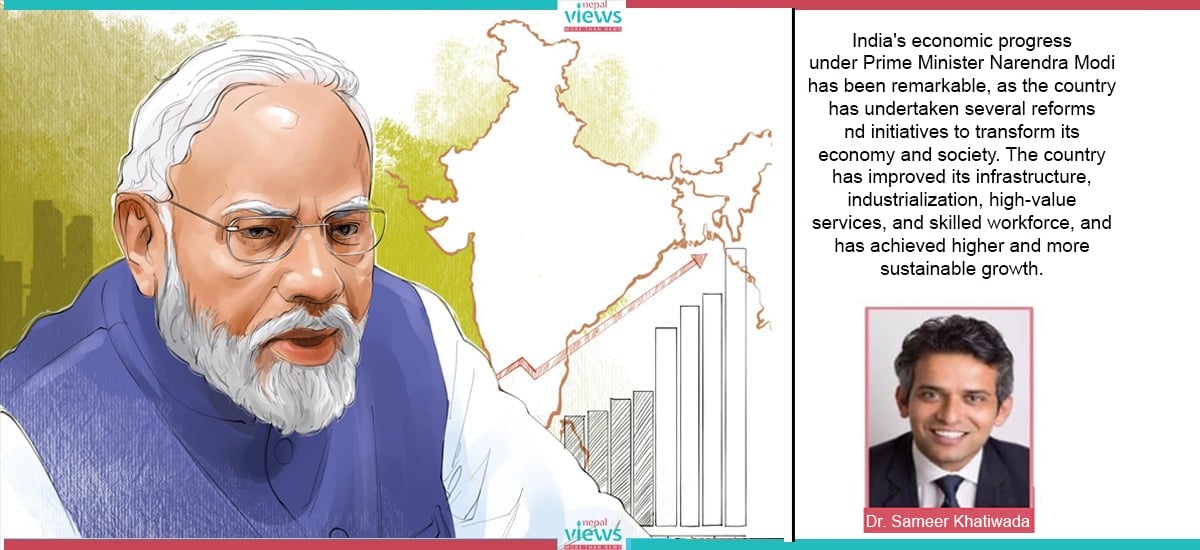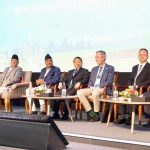India is one of the fastest-growing economies in the world, with a gross domestic product (GDP) of $3.7 trillion in 2023. The country has made significant strides in reducing poverty, improving human development, and enhancing its global competitiveness. Under the leadership of Prime Minister Narendra Modi, who came to power in 2014, India has embarked on a series of ambitious reforms to transform its economy and society.
India’s average annual gross domestic product (GDP) grew by 7.0% between FY 2010 and 2019, supported by sound macroeconomic management and economic policies that have contributed to a substantial reduction in poverty. However, in FY 2021, GDP contracted sharply by 6.6% because of the COVID-19 pandemic. Growth recovered strongly to 8.7% in FY 2022, and the momentum is expected to continue.
Modi government has managed to sustain strong economic growth for the past decade because of a series of structural reform programs critical for economic growth and job creation. Some of the key areas of reform include:
(i) Infrastructure development: Such as the construction of roads, railways, airports, ports, and power plants
(ii) Industrialization: Especially in the manufacturing sector, through initiatives like Make in India, Startup India, and Atmanirbhar Bharat
(iii) High-value services: Such as information technology (IT), biotechnology, and digital economy, through programs like Digital India, Skill India, and Smart Cities
(iv) Skilled workforce: Through enhancing the quality and access to education, training, and employment opportunities
India’s economic success in the last decade under Prime Minister Modi provides several key lessons for Nepal. In this article, I will review some of the major reforms and achievements of the Modi government and their impact on India’s economic growth and development.
Infrastructure Development
Infrastructure is the backbone of any economy, as it facilitates the movement of goods, services, and people, and enhances the productivity and efficiency of various sectors. The Modi government has given a high priority to infrastructure development and has launched several flagship schemes and projects to improve the quality and quantity of India’s infrastructure.
Some of the notable examples are:
(i) The National Infrastructure Pipeline (NIP), which aims to invest $1.4 trillion in various infrastructure projects across 23 sectors by 2025
(ii) The Bharatmala Pariyojana, which aims to construct 26,000 lengths of economic corridors
(iii) The Sagarmala Project, which aims to develop the coastal and maritime infrastructure of India, and enhance its port capacity, connectivity, and trade
(iv) The Dedicated Freight Corridors (DFCs), which aim to create high-speed and high-capacity rail corridors for freight movement, and reduce the congestion and cost of transportation.
These infrastructure development plans are critical for increased economic competitiveness, better links to global value chains (GVCs), and higher export revenue.
Economic evidence shows that these infrastructure projects under Prime Minister Modi have had a positive impact on India’s economic growth, as they have created jobs, boosted demand, improved connectivity, and enhanced competitiveness.
According to the Economic Survey 2019-20, every $1 billion invested in infrastructure creates 40,000 direct and 100,000 indirect jobs. Moreover, according to the World Bank, improving infrastructure quality can increase India’s GDP per capita by 1.3 percentage points in the long run.
Industrialization
Industrialization is the process of transforming an economy from being primarily based on agriculture and services to being based on manufacturing and other industries.
Industrialization is essential for achieving higher and more sustainable growth, as it increases the value addition, diversification, and innovation of the economy. The Modi government has launched several initiatives to promote industrialization, especially in the manufacturing sector, which accounts for about 16% of India’s GDP.
Some of the key initiatives launched by the government of India include:
(i) Make in India: Aims to make India a global manufacturing hub, by attracting foreign and domestic investment, improving the ease of doing business, and creating a conducive environment for the sector.
(ii) Startup India: Aims to foster entrepreneurship and innovation, by providing tax incentives, funding support, regulatory reforms, and mentoring for startups.
(iii) Atmanirbhar Bharat: Means self-reliant India, aims to reduce India’s dependence on imports, and increase its domestic production and consumption, by creating a favorable ecosystem for local manufacturers and suppliers.
Before, during, and since the COVID-19 pandemic, the government of India under Prime Minister Modi pursued structural reforms to build economic competitiveness and create jobs. Major reforms include
(A) Introducing the Insolvency and Bankruptcy Code in 2016 to rationalize nonperforming loans
(B) Launching the goods and services tax (GST) in 2017, thereby integrating a multilayered indirect tax system into a single unified tax
(C) Improving the ease of doing business by establishing a national single-window system, reducing the compliance burden on firms, and liberalizing business regulations
(D) Reforming income tax to augment domestic and foreign investments
Post-COVID-19, further reforms have been initiated to accelerate the process, including the consolidation of 29 central laws governing labor into 4 codes to ease labor management, initiating new export promotion schemes, attracting foreign direct investments, and launching education and health schemes, among others.
These and other initiatives have had a positive impact on India’s industrialization, as they have increased the investment, production, and exports of the manufacturing sector.
According to the Department for Promotion of Industry and Internal Trade (DPIIT), the foreign direct investment (FDI) inflows in the manufacturing sector increased from $16 billion in 2013-14 to $36 billion in 2019-20.
Moreover, according to the Ministry of Commerce and Industry, the manufacturing output grew by 5.7% in 2018-19, and the manufacturing exports increased from $298 billion in 2013-14 to $330 billion in 2019-20.
High-Value Services
High-value services are those that provide high returns, high quality, and high innovation to the economy, such as information technology (IT), biotechnology, and digital economy. High-value services are important for achieving higher and more inclusive growth, as they create more skilled and well-paid jobs, increase the competitiveness and efficiency of various sectors, and enhance the social and environmental welfare of the society.
The Modi government has launched several programs to promote high-value services, such as:
(i) Digital India: Aims to transform India into a digitally empowered society and knowledge economy, by providing digital infrastructure, services, and literacy to all citizens.
(ii) Skill India: Aims to train and equip the youth with the relevant skills and knowledge for the emerging sectors and markets, by providing quality education, vocational training, and certification.
(iii) Smart Cities: Aims to develop urban areas that are livable, sustainable, and resilient, by using technology, innovation, and citizen participation to improve the quality of life and governance.
These and other programs have had a positive impact on India’s high-value services, as they have increased the growth, employment, and exports of the sector.
According to the Ministry of Electronics and Information Technology, the IT sector contributed 7.7% to India’s GDP in 2019-20 and employed 4.36 million people. Moreover, according to the National Association of Software and Services Companies (NASSCOM), IT exports grew by 8.1% in 2019-20 and reached $147 billion.
Skilled Workforce
A skilled workforce is the human capital of any economy, as it determines the productivity, innovation, and competitiveness of various sectors. A skilled workforce is essential for achieving higher and more equitable growth, as it increases the income, employability, and social mobility of the people, and reduces the inequality and poverty of society.
The Modi government has given a high emphasis on enhancing the quality and access to education, training, and employment opportunities for the workforce, by implementing various schemes and policies, such as:
(i) The National Education Policy (NEP) 2020: Aims to overhaul the education system of India, by making it more holistic, flexible, and multidisciplinary, and by increasing the gross enrolment ratio, the quality of learning outcomes, and the integration of technology.
(ii) The Pradhan Mantri Kaushal Vikas Yojana (PMKVY): Aims to provide skill development training to the youth, by aligning the courses with the industry standards, and by providing placement assistance and recognition of prior learning.
(iii) The Pradhan Mantri Rozgar Protsahan Yojana (PMRPY): Aims to incentivize employers to create new jobs, by providing social security benefits to the new employees, and by reducing the cost of hiring.
These and other schemes and policies have had a positive impact on India’s skilled workforce, as they have increased the education, training, and employment opportunities for the people.
According to the Ministry of Human Resource Development, the gross enrolment ratio in higher education increased from 25.8% in 2013-14 to 27.4% in 2018-19.
Moreover, according to the Ministry of Skill Development and Entrepreneurship, the PMKVY will train 9.2 million candidates in various skills by 2020.
Furthermore, according to the Ministry of Labour and Employment, the PMRPY benefited 1.2 crore employees and 1.5 lakh employers by 2020.
Conclusion
India’s economic progress under Prime Minister Narendra Modi has been remarkable, as the country has undertaken several reforms and initiatives to transform its economy and society. The country has improved its infrastructure, industrialization, high-value services, and skilled workforce, and has achieved higher and more sustainable growth.
The country has also faced some challenges, such as the COVID-19 pandemic, the slowdown in demand, and the social unrest, which have affected its economic performance and outlook. However, the country has shown resilience and adaptability and has taken various measures to mitigate the impact and recover from the crisis.
India’s experience offers valuable insights and lessons for Nepal as it seeks to achieve 7% to 8% economic growth and improve the well-being of all Nepalis. We do not need to look far, but to India for effective programs and policies to achieve strong and sustainable economic growth.
(Nepali version of the article)











